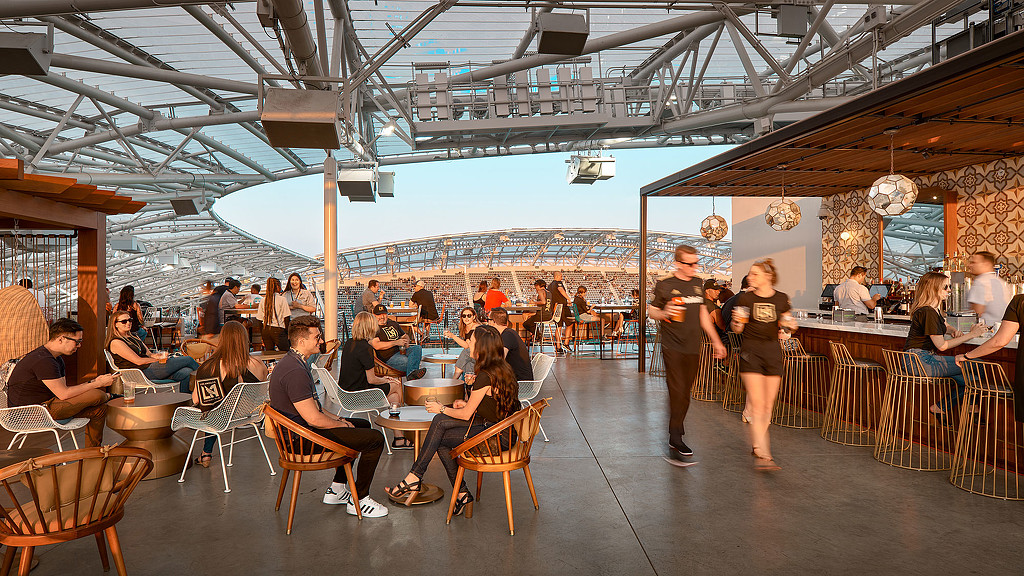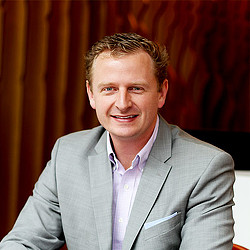The Trends Redefining Sports Venues in 2022 and Beyond
December 20, 2021 | By Ryan Sickman
Editor’s Note: This blog is part of our Design Forecast blog series, looking at what’s next in 2022 and beyond. Here, we sit down with Ryan Sickman, global leader for Gensler Sports, and Keith Collins, former development director for Gensler Sports, to discuss what’s next for sports venue design.
What features do you add most often to venue designs to improve the spectator experience?
Keith: There’s a wide variety of premium products that’s expected in these venues. It’s no longer the older model of just coming and sitting in a seat and watching the game. Sponsor zones, loge boxes, and bunker suites are all unique ways that people at different levels of entry, cost-wise, can come in to see a game and experience it in a new way.
Ryan: We’re getting out of the rudimentary general admission seat vs. suite seat dynamic. The last time we counted, we’ve been installing upwards of 25 different types of seating experiences.
Everything we do is about the human experience. Some people go to watch the game, some go to be social with their friends, but ultimately, they want to be together with a mass group of people, all with the same common goal of experiencing a sporting event in-person.
How are you creating a more memorable and enjoyable experience?
Ryan: Every fan coming to the game expects a higher level of experience. Neighborhoods, better food & beverage, access to a bar — people are willing to pay for that kind of stuff, but only if you provide the experience. If the experience isn’t there, you can’t capitalize on that revenue stream.
Keith: People will buy a lower priced or standing room only ticket just to get in the venue and then find that plussed-up club option once inside. They are still having an awesome game day experience, just not from their assigned seat. It’s just not about that anymore.
It seems like seating capacity has actually gotten smaller in new stadiums. How has that affected overall design trends for venues?
Keith: Stadiums are downsizing capacity a fair amount. It’s no longer required that you have a specific amount of seats to host specific events anymore. We’re looking at places that are starting out building new venues for much less seats than we have historically designed for, and renovations are significantly reducing capacities. That whole model has changed because they’d rather use that space for sponsor decks or other opportunities to offer these different in-venue experiences.
Ryan: And even with those lower capacities, they’re seeing increased revenue opportunities because of the types of experiences that we’re willing to provide people. Let me be clear: buildings are not getting smaller from an overall square footage, but only in capacity. Those additional space allocations are being put into the guest experiences at all levels of seating.
How can design help improve player performance?
Ryan: It really gets back to our training facility design. A player’s performance on the field is dictated long before they actually walk into the stadium. The prototypical old school training facility was a locker room, weight room, and training room. Now, it’s all about biometric monitoring and performance for each individual player. Recovery is also huge — that’s where the biggest change has occurred in the last 10 or 15 years. Those dedicated areas are starting to be put into the training facility. Not only are they trying to wow recruits, but once they’re there, they’re taking care of them in a way that historically hasn’t been done.
How are issues of sustainability shaping your practice?
Keith: These are large buildings with a ton of embodied carbon, so it is critical that we consider both renovation and reuse of existing facilities as an option or work harder with our engineering and construction partners to implement sustainable systems and construction techniques that move these projects closer to net-carbon neutrality.
The sports practice needs to evolve the way we approach the design of our projects so that resilience and sustainability practices are built into projects from the outset. It’s our job to prioritize resilient sports design as the recommended first choice so that we can incorporate it cost effectively and get clients to value Gensler’s commitment to resilience.
What projects are you excited about right now?
Ryan: Look at what we did with BMO Stadium, home of Major League Soccer’s Los Angeles Football Club (LAFC). We talked to the fans, we asked what they wanted, we gave it to them, and they responded by supporting the team, showing up, selling out games, and creating an atmosphere that’s intimidating to play in — that’s a successful experience that players and fans both want to be a part of.
Simultaneously, from an overall brand and team standpoint, what they did at the training facility was exactly what they needed in Southern California: A mixture of indoor and outdoor, but with all the tools players need to be successful on the field. So, when you think about the brand — LAFC built a stadium, a fan base, a team atmosphere, and then cohesively moved forward to succeed on the field and in their overall spectator experience.
Keith: Another great project is San Diego State Snapdragon Stadium. The 35,000-seat venue is the cornerstone of reinvention in Mission Valley, replacing what was a sea of parking around Qualcomm Stadium with a new satellite campus for the university with this stadium as its sports anchor.
We designed concourse and in-bowl experiences to engage fans in zones that are authentically referential to local neighborhoods. We also created open exterior concourses to facilitate a variety of on- and off-day uses, including a push for carless tailgating and extended mobility that focuses on direct metro train access. It’s really redefining how SDSU is going to work as a campus and has extended San Diego as a district.
For media inquiries, email .

